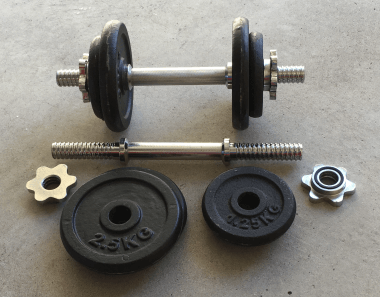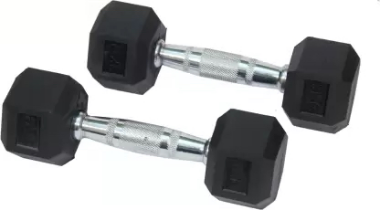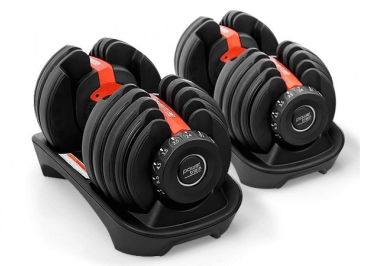Adjustable Dumbbells
If you are just starting out, other than using your body weight, a pair of adjustable dumbbells is more than sufficient to give you great workouts.
Once you’re comfortable using dumbbells and become more advanced with your workouts, having a second pair of dumbbells is ideal. You can use one pair for lightweight exercises and another for heavyweight exercises.
Benefits of training with dumbbells
Versatility
You can perform a vast range of exercises and exercise variations with dumbbells. You can use one dumbbell or a pair for your workouts.
Train multiple muscle groups for optimal performance
One of the most significant benefits of dumbbell training is that you have to control two independent weights rather than controlling a barbell with both arms simultaneously.
As a result, dumbbell exercises allow you to train your major muscle groups (movers) and stabiliser muscles. The major muscles or movers are the big muscle groups that help your body move and do most of the work when performing an exercise. The stabilisers are the smaller muscles responsible for keeping parts of the body stable throughout the movement, protecting the joints so that the movers can do their job efficiently.
For example, when performing an exercise like a squat and press (below), you are training your lower and upper body muscle groups and require the input of your core muscles. In addition, your core stabiliser muscles must work in all directions to help control the weight. Hence, you’re able to perform the exercise safely and effectively.
Improve strength and muscular imbalances
Another advantage of using dumbbells is they identify and uncover any strength or muscular imbalances between your left and right sides. These imbalances are less noticeable when holding a barbell with both hands but are more pronounced when using dumbbells. This is because dumbbells allow each arm to work independently. Imbalances can be noticeable if you haven’t done strength training before or not for a while.
For example, when performing a dumbbell chest press, you might notice that one arm feels stronger and pushes the dumbbell up a little easier than the weaker arm. These weaknesses are corrected by performing single-arm exercises, which can help strengthen the weaker muscles.
Types of dumbbell exercises
Bilateral exercises
Bilateral dumbbell exercises are performed using both limbs simultaneously, such as shoulder press, chest press, and goblet squat.
Unilateral exercises
Unilateral dumbbell exercises are performed using one limb, such as one-arm shoulder press, chest press, or split squat. The main advantage of unilateral exercises is they allow us to isolate the weaker side to help strengthen it.
Types of dumbbells
There are three main varieties of dumbbells:

Adjustable dumbbells
These consist of a bar and weight plates that slide onto either end and are held on with clips or collars. The screw-on collars are often the best. The great thing about adjustable dumbbells is there’s nothing to set up. Just change the weight for the particular exercise routine you’re doing, and off you go. These are generally the most convenient and the most cost-friendly option of all dumbbells.

Fixed weight dumbbells
These dumbbells cannot be adjusted. They come as a set weight, so you would need a variety of differently weighted dumbbells to have a good workout. However, if you are willing to spend the money and have the space, these dumbbells can be a good investment.
“Selectorised” adjustable dumbbells

These dumbbells can also be adjusted to the desired weight when resting in their dumbbell stand. They have a weight selection dial and a smart locking system. Adjust the number of plates that follow the handle when lifted from the stand by just turning the dial on the dumbbells. These cost a lot more than your standard adjustable dumbbells but are well worth it. Finally, you have a set of dumbbells that are space-efficient and can be adjusted from 2kgs up to 40kgs quick and easy in seconds!
References:
‘Dumbbell WOD Bible’ by P Selter, 2015.
‘Dumbbell Training’ by Allen Hedrick, 2014.
‘Men’s Health Ultimate Dumbbell Guide’ by Myatt Murphy, 2007.